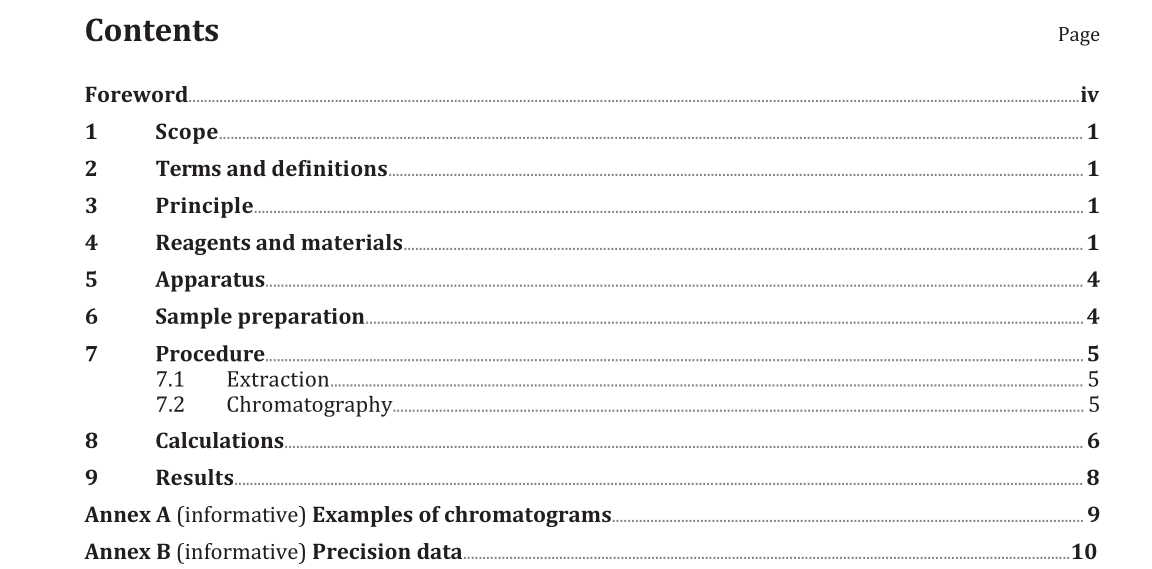BS ISO 20638:2015 pdf download.Infant formula — Determination of nucleotides by liquid chromatography
1 Scope
This International Standard specifies a method for the quantitative determination of 5′-mononucleotides in infant formula in solid (i.e. powders) or liquid (i.e. ready-to-feed liquids and liquid concentrates) forms using liquid chromatography.
2 Terms and definitions
For the purposes of this document, the following terms and definitions apply.
2.1 infant formula
breast-milk substitute specially manufactured to satisfy, by itself, the nutritional requirements of infants during the first months of life up to the introduction of appropriate complementary feeding [SOURCE: Codex Standard 72-1981]
3 Principle
The sample is dissolved in high-salt solution to inhibit protein and fat interactions. The 5′-mononucleotides — uridine 5′-monophosphate (UMP), inosine 5′-monophosphate (IMP), adenosine 5′-monophosphate (AMP), guanosine 5′-monophosphate (GMP), and cytidine 5′-monophosphate (CMP) — are separated from the sample matrix by strong-anion exchange solid-phase extraction (SPE),followed by chromatographic analysis using a C18 stationary phase with gradient elution, UV detection, and quantitation by an internal standard technique using thymidine 5′-monophosphate (TMP). [1]
4 Reagents and materials
During the analysis, unless otherwise stated, use only reagents of recognized analytical grade and distilled or demineralized water or water of equivalent purity.
4.1 Standards, ≥ 99 % pure (Sigma 1) or equivalent). Nucleotide sodium salts or sodium salt hydrates may be substituted if free acid forms are not readily available.
4.1.1 TMP, thymidine 5′-monophosphate, CAS No. 365-07-1.
4.1.2 AMP, adenosine 5′-monophosphate, CAS No. 61-19-8.
4.1.3 CMP, cytidine 5′-monophosphate, CAS No. 63-37-6.
4.1.4 GMP, guanosine 5′-monophosphate, CAS No. 85-32-5.
4.1.5 IMP, inosine 5′-monophosphate, CAS No. 131-99-7.
4.1.6 UMP, uridine 5′-monophosphate, CAS No. 58-97-9.
4.2 Potassium bromide (KBr).
4.3 Potassium dihydrogen phosphate (KH 2 PO 4 ).
4.4 Orthophosphoric acid (H 3 PO 4 ).
4.5 Potassium hydroxide (KOH).
4.6 Ethylenediaminetetraacetic acid, disodium salt dihydrate (EDTA).
4.7 Sodium chloride (NaCl).
4.8 Methanol (CH 3 OH).
4.9 Reagent preparation
4.9.1 Standardizing buffer (KH 2 PO 4 , c = 0,25 mol/l, pH = 3,5). Dissolve 34,0 g KH 2 PO 4 (4.3) in 900 ml water and adjust pH to 3,5 with orthophosphoric acid (4.4). Dilute to 1 l.
4.9.2 Extraction solution (NaCl, c = 1 mol/l, EDTA c = 4 mmol/l). Dissolve 58,5 g NaCl (4.7) and 1,5 g EDTA (4.6). Dilute in 1 l water.
4.9.3 Wash solution (KBr, c = 0,3 mol/l). Dissolve 3,6 g KBr (4.2) in 100 ml water.
4.9.4 Eluent solution (KH 2 PO 4 , c = 0,5 mol/l, pH = 3,0). Dissolve 6,8 g KH 2 PO 4 (4.3) in 90 ml water and adjust pH to 3,0 with orthophosphoric acid (4.4). Dilute to 100 ml.
4.9.5 Mobile phase A (KH 2 PO 4 , c = 10 mmol/l, pH = 5,6). Dissolve 1,4 g KH 2 PO 4 (4.3) in 900 ml water and adjust pH to 5,6 ± 0,1 with KOH solution (10 % m/v). Dilute to 1 l with water. Make daily as microbial growth often occurs at room temperature in phosphate buffers that contain little or no organic solvent.
4.9.6 Mobile phase B, 100 % methanol (4.8).
4.10 Standard preparation
4.10.1 Stock standard solutions, ρ approximately 1 mg/ml. Accurately weigh approximately 50 mg each nucleotide 5′-monophosphate into separate 50 ml volumetric flasks. Add 40 ml water, mix until dissolved, and make to volume with water.
4.10.2 Purity standard solutions. Pipette 1,0 ml each stock standard (4.10.1) into separate 50 ml volumetric flasks, make to volume with standardizing buffer (4.9.1), and measure absorbance at the appropriate λ max to determine the concentration of each nucleotide stock standard. See Table 1 and References [1] and [2].
BS ISO 20638:2015 pdf download
